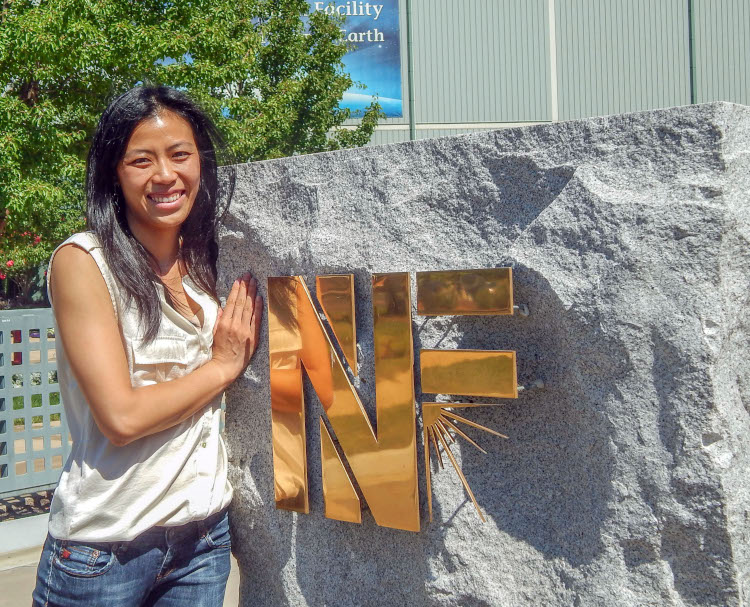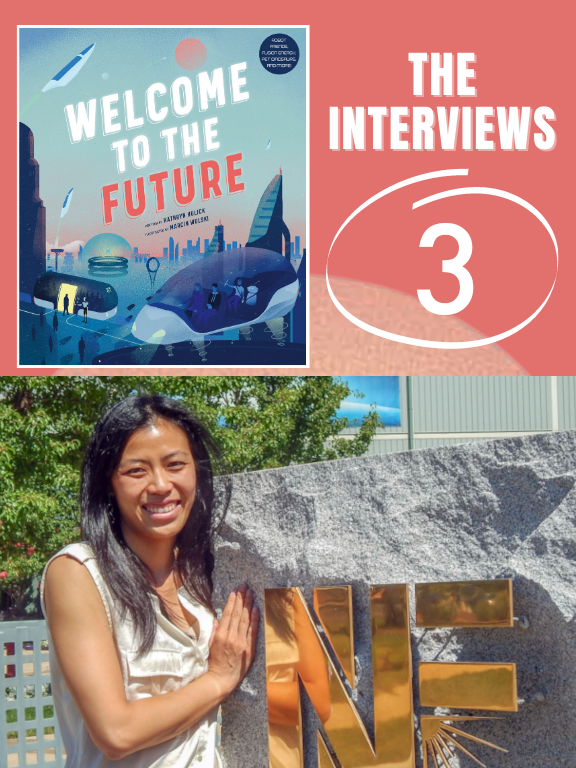In this series of interviews. I ask scientists, engineers, and ethicists how technology might change our future. We had these conversations during the research for my book, Welcome to the Future (Quarto, 2021).
Interview 3 – Tammy Ma
Dr. Tammy Ma is an experimental physicist at the Lawrence Livermore National Laboratory’s National Ignition Facility (NIF). She gets to fire the world’s biggest laser in experiments that could someday lead to a way to produce energy from fusion. Fusion is a nuclear reaction that merges two elements, typically isotopes of hydrogen, producing heavier elements and lots of energy. Fusion is what keeps the sun and other stars shining. However, here on Earth, it still takes more energy to start and sustain a fusion reaction than that reaction produces. Ma and other fusion scientists hope to change that. I spoke with her in August 2019.
What would it be like to live in a world powered by fusion energy?
A future powered by fusion means we no longer need coal-powered plants or natural gas plants. So the environment would get cleaner. Fusion power plants would also be safe. You could build them alongside cities and you could have a lot more economic growth. Hopefully you could help eliminate wars that might be fought over energy resources.
Do you think we will power our world with fusion in the future?
I do. Humans know how to make fusion work. Hydrogen bombs demonstrate that we know how to get a lot of energy out of fusion. But we want to do it in a controlled reaction. That’s why we’re pursuing either laser-driven or magnetic fusion. And there are other advanced methods as well. We are trying to do it on a small scale in the laboratory. I can say we’ve made a lot of progress over the past few decades. Specifically for laser fusion, we’ve made a lot of progress in last few years. I do believe that if our level of [financial] support is maintained or grows, within 10 years or so we should be able to demonstrate what we call ignition in the laboratory.
What is ignition?
It means we get more energy out than we put in with the energy driver, which in our case would be the laser.
How soon do you predict that we’ll have working fusion power plants?
It does take a long time to adapt to any new energy technology. So if we demonstrate [fusion power] ten years from now, it could take another thirty years to get it up and running and producing efficient energy for the grid. That’s forty to fifty years from now — it’s a long haul.
Besides the scientific challenge of demonstrating fusion ignition, there are all sorts of engineering challenges. For [laser fusion], a power plant would have to repeat the experiment ten times a second. Now, we’re doing it once every eight hours. So the lasers will have to fire faster, the targets you shoot have to be cheaper, you need to build a facility that could absorb the neutrons coming out and convert the energy into heat that runs a turbine [to produce electricity]. But there’s a road map for fusion energy that we’re making good progress on. I think in my lifetime we’ll be building fusion power plants.
Would you want to live in a fusion-powered world?
I don’t think there are downsides. I imagine other energy technology will progress as well. Depending on where you live, if it’s out in the desert, maybe solar power will be more economical. In Northern Europe geothermal may be the energy source of choice. The thing with fusion is,it probably has to be fairly large scale. I don’t forsee that we can run cars off of fusion power [engines] any time soon. Eventually, maybe. But for a while fusion would mostly be replacing coal-powered plants or fission nuclear plants.
What do you wish people understood about fusion?
I wish people would stop talking about cold fusion. Those experiments were debunked. Fusion is hot. I also wish more people knew about the overall potential of fusion. Even though it will still take many more decades, that investment is worth it. We have to be patient. We have to chip away at it. The overall benefit to society far outweighs the cost we’re putting into it now. It is research dollars well spent. And it’s hard! That’s why we haven’t gotten there yet.
What makes fusion so difficult?
Fundamentally, what you need to do to get atoms to fuse is overcome the Coulomb barrier. That’s the natural repulsion between two atoms. You have to get your atoms very dense and very hot. Those are extreme conditions that take very specific tools. And in our case, we use lasers to push the particles together so that they fuse. Because we go very hot and very dense as we’re trying to compress the fuel capsule, the pressure gets so great that it blows itself apart. We can only contain it for a very small amount of time. Fusion doesn’t naturally occur on Earth. It occurs in the sun and it occurs in stars. Those are giant bodies! It’s so cool that human beings are able to replicate the process that occurs in the center of the sun.
Inside a star such as the sun, gravity traps atoms together in a hot, dense space where they fuse. You use lasers to create the same effect. Are you making stars?
We really are. We call it making stars. The conditions that we are able to achieve are similar to what you might get in stars, the cores of giant planets, supernovae, or gamma ray bursts. Every time we do a shot at the NIF, we are the hottest place in the solar system.
What specific problems are you dealing with as you try to reach ignition?
We are trying to maintain symmetry as we do the implosion. The implosion has to be spherical. We’re going from a 2 mm diameter to about 50 microns, which is half the diameter of a human hair. If you deviate from [the round shape], you are wasting kinetic energy.
A second big challenge is hydrodynamic instabilities, which are perturbations on the surface of the capsule [which holds the fusion fuel]. These are little bumps or divots that come from normal fabrication. They grow exponentially as we are doing this enormous compression. And they may push chunks of the capsule into [the fusion fuel]. That quenches the burn before it actually starts.
No two targets are exactly the same. There’s always something that you might not have expected that might affect the implosion in a slightly different way. We are trying to improve the target, trying to improve the laser, trying to improve the diagnostic instruments to measure things better, and also trying to improve the physics code to interpret the data better. We may run hundreds of thousands of simulations per experimental shot to try to understand the data. All these things have to improve.
What will you feel like when someone (maybe you!) finally achieves ignition?
It will be a huge celebration for all humankind. I would think it would be a little like landing on the moon. It’s something that many nations have been working on for many decades. It’s something that will touch every human on Earth — if we can make it work. If it becomes an energy source, it’s tech you would want to deploy everywhere around the world.
It’s a clean, plentiful, energy source that potentially could improve the lives of everybody. It won’t be cheap initially, simply because it’s a new technology. But in the long term, once you know how to do it, it’s mostly an engineering problem to put together the power plants and run them.
The fuel you need for fusion is accessible to everybody. Deuterium [an isotope of hydrogen] naturally occurs in seawater, and almost everybody has the ocean. You don’t have to mine for it. You don’t have to wait a long time to harvest it. It’s there.
Climate change is a big problem now. Will fusion be able to help reduce the amount of greenhouse gases we emit?
When we can make fusion work, yes, it will definitely help with climate change. It’s completely carbon free. It’s a sustainable energy source. We can easily get the fuel without damaging the environment. But fusion is several decades out. In the meantime, we need to learn to steward the environment and our planet and prevent climate change from becoming much worse. In the immediate future, I think solar can help us fill the gap. Solar panels are becoming quite efficient. The cost is going down significantly and their operation is becoming far more reliable.
What are the most important ethical issues surrounding the future of energy production and usage?
Equality of distribution, equality of access is necessary in order to lift developing countries up economically and technologically. What we have right now is just a few main actors in the world generating most of the global warming, but it is the poorer nations that will suffer the most.
Any last words?
The exciting thing about fusion and what keeps me in the field is that this is one of the great scientific challenges of humankind. Besides it being a potential energy resource, it’s a really fun problem to work on.


